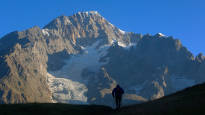of Great Britain Jasmin Paris40, became the first woman to finish the Barkley marathons, one of the world’s toughest ultrarunning races, on Friday in Tennessee, USA.
Paris arrived at the finish line of the approximately 160-kilometer race one minute and 39 seconds before the 60-hour time limit expired. Only 20 people have reached the finish line within the time limit in the current form of the race, which has been held since 1989.
Paris said she felt In an interview with the BBC “embarrassing relief” after reaching the finish line.
– I am really happy that I succeeded in my goal after three years of trying. I’m also glad that I did this in a way for all women – not just runners – but any woman who wants to challenge herself, but doesn’t necessarily have the necessary confidence, Paris said.
There are a lot of fallen trees and thorn bushes on the route that goes through the closed forest. Paris’ hands were full of wounds of different sizes in the paint.
– I hit a lot of thorn bushes, it was like someone cut me. It happened again every five laps.
In addition to Paris, four men reached the finish line this year, of which the Ukrainian-Canadian clocked a time of 58 hours, 44 minutes and 59 seconds. Ihor Verys.
In the past, at best, three runners have reached the finish line at the same time. The all-time record is Brett Maunen 52.03.08 from 2012.
Finns have not made it to the finish line in the race. Ultra runner Mikael Heerman has participated in the competition in 2017 and 2019. He values Paris’s performance very highly.
– This is a huge milestone for the sport. I believe that it is also reflected in the amount of news coverage. Probably the best performance of this decade in this area. I really, really appreciate it, says Heerman, who ran the Spartathlon in his career, among other things.
– When you think about how strict he was throughout the race. At no point did he “break his spine”. Even though he knew the situation must be really tight, he continued to push until the end. You can’t help but admire.
A strange competition
Barkley marathons are held annually in Tennessee, USA, in tough terrain, and consist of five runs over 30 kilometers. A distinctive event began Martin Luther King having shot By James Earl Ray inspired by the 1977 prison break.
Ray escaped from a nearby prison and traveled 19 kilometers through the woods in just over 54 hours before being caught. Gary “Lazarus Lake” Cantrell considered the performance weak and threatened that he would be able to do at least one hundred miles, i.e. 160 kilometers, when the idea of the competition was born.
Cantrell’s neighbor and running buddy Barry Barkley the race named after was organized for the first time in 1986. Before 1989, races of 80–95 kilometers were run, after which they moved to a distance of 160 kilometers.
Only 40 runners are accepted into the race, who are selected based on motivation letters from among thousands of applicants.
The competition may start at any time on the day of the competition. The start happens when Cantrell, the father of the race, lights a cigarette. As a pre-warning, he blows into the seashell an hour before.
In addition to running, they have to find books on the runs, from which they have to tear out the page corresponding to their race number as proof of their performance.
At the mercy of the weather
The speed of the racers does not necessarily seem very fast to the eye of the street person. Mikael Heerman says that it is due to the exceptional terrain and the fact that the racers are not informed very precisely. Passing the race requires good conditions.
– If the weather is even wetter, the terrain becomes quite impassable and the progress slows down considerably, says Heerman.
The race takes place on unmarked routes in a closed forest, both during the day and at night. The books that serve as check marks are not marked in any way, but you have to find them.
– Those who have been to the competition before know in which rock hole it can be found. Information passes from one runner to another.
On the full trip, there will be a height difference of about 18,000 meters, which is equivalent to two trips to the Himalayas and back.
– The individual climb is only about 300-400 vertical meters, but the route is built into the terrain in such a way that it goes up or down all the time. There aren’t many flat sections.
Heerman made it to the second round out of five with both of his participation times. The first time knee pains stopped the trip, on the second attempt the weather entered the picture.
– In one of the stone holes, I waited for the rain to stop. It meant that kind of semi-hypothermia. The operating conditions were quite poor. It was raining with sleet from zero degrees and the equipment was quite wrong for that weather. That round ended because of that.
Heerman says that he applied and got into the competition even after his two attempts.
– I have canceled my participation because my body has not allowed me to do the training required for the competition.
